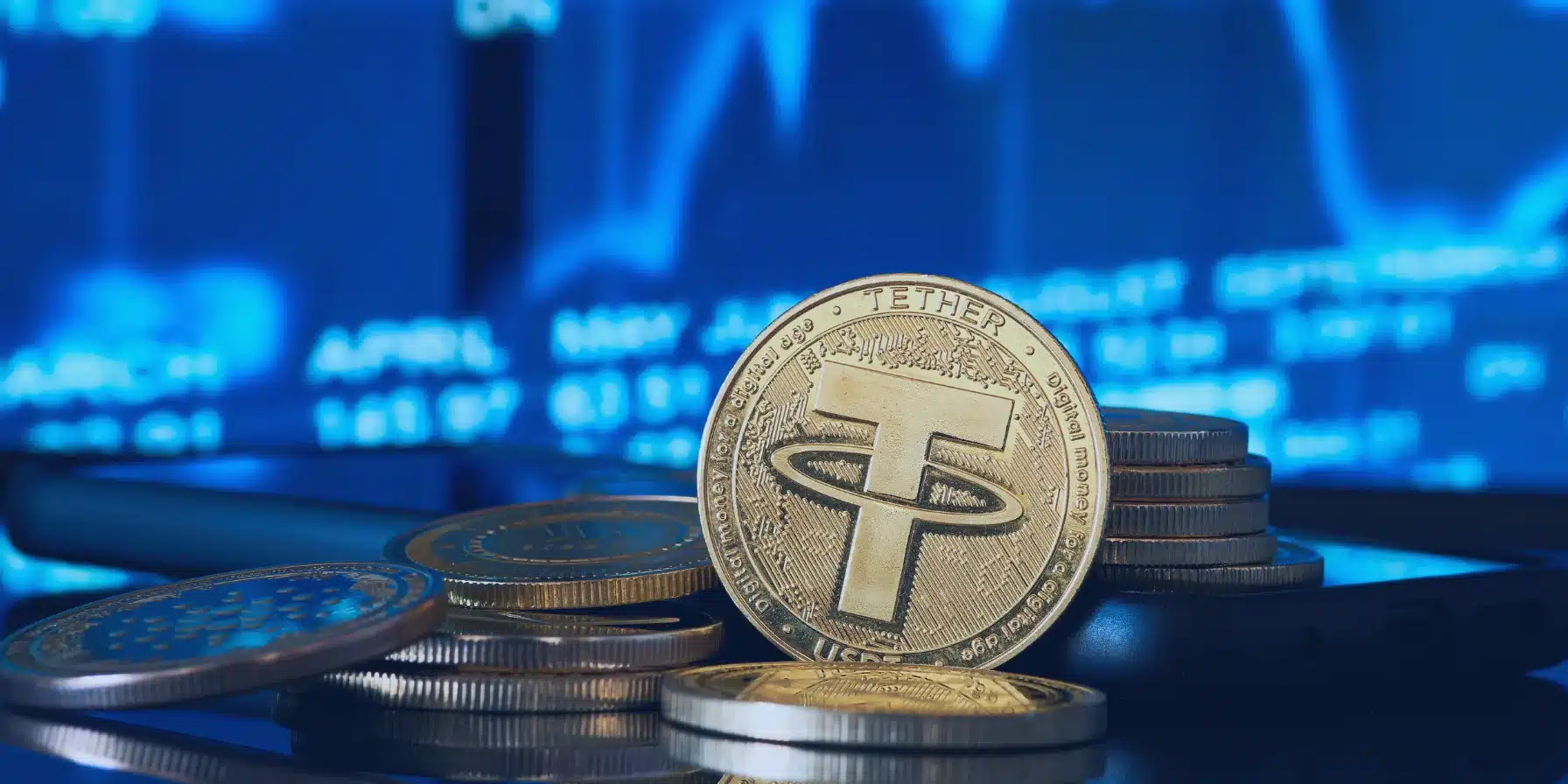Stablecoins have emerged as a fascinating and essential component of the shifting cryptocurrency landscape. But how do stablecoins work, what are they, and why are they garnering so much attention?
This article delves into the world of stablecoins, untangling their significance and mechanics.
An Overview of Stablecoins
At their core, stablecoins are digital assets designed to maintain a stable value, hence the name. Unlike other cryptocurrencies, such as Litecoin or Ethereum, known for their volatility, stablecoins aim to provide a predictable value.
Stablecoins achieve this stability by pegging their value to an underlying asset, typically fiat currencies such as the US Dollar or Euro. Hence, stablecoins bridge the gap between crypto and traditional financial systems, offering users the best of both worlds. They also play a crucial role in addressing crypto volatility.
While cryptocurrencies have gained popularity for their decentralized nature and potential for high returns, their volatility has hindered their adoption as a medium of exchange and store of value. Stablecoins provide a solution by offering a reliable unit of account and a stable store of value. This stability broadens the use cases and opportunities within the cryptocurrency ecosystem.
So, how do stablecoins achieve and maintain their stability? The mechanics behind stablecoins can vary depending on their type. Depending on their category, fiat currencies back stablecoins, meaning they (stablecoins) hold a reserve of traditional currencies to ensure the stability of their value.
Others employ algorithms and smart contracts to dynamically adjust the supply of stablecoins in response to market conditions. There are also stablecoins backed by commodities, such as precious metals or oil, to provide a tangible asset base.
This article will explore different stablecoins, including:
- Fiat backed stablecoins
- Algorithmic stablecoins
- Commodity backed stablecoins
We’ll delve into their inner workings, advantages and potential risks. Additionally, the article will discuss the benefits and use cases of stablecoins, their regulatory challenges and their prospects.

By the end of this article, you’ll have a comprehensive understanding of stablecoins, their significance in the financial world and their potential impact on the future of finance.
Exploring Different Paths to Stability
Stablecoins come in various forms, each designed to achieve price stability and provide resilience amidst market volatility. Let’s explore the different stablecoins.
Fiat Currency-backed Stablecoins
These fiat-backed stablecoins peg to traditional fiat currencies like the US Dollar, Euro, or Japanese Yen. A centralized supports fiat-backed stablecoins with reserves of the respective fiat currency. In essence, for each unit of stablecoin issued, an equivalent amount of fiat currency is held.
The value and stability of fiat-backed stablecoins rely on the trustworthiness and transparency of the entity holding the reserves. An example of a popular fiat-backed stablecoin is Tether (USDT).
Fiat-backed stablecoins provide stability and facilitate easy conversion into assets such as traditional fiat currencies by linking their value to familiar fiat currencies.
Crypto-Backed Stablecoins
Also known as collateralized stablecoins, crypto-backed stablecoins utilize other crypto assets as collateral to maintain price stability. Smart contracts govern the issuance and redemption of these stablecoins. Users lock their crypto assets into a smart contract and receive a corresponding stablecoin amount.
The locked crypto assets act as collateral, ensuring the stability and value of the stablecoin. If the value of the collateral falls below a certain threshold, the smart contract may liquidate the collateral to maintain the stablecoin’s price stability. MakerDAO’s DAI is an example of a crypto-backed stablecoin backed by Ethereum-based collateral.
Commodity-Backed Stablecoins
These stablecoins, known as commodity-backed stablecoins, fix their value on assets such as precious metals like gold and silver or commodities like oil and natural gas. By anchoring their worth to tangible and widely recognized physical assets, these stablecoins provide a reliable source of support.
While commodity-backed stablecoins provide a unique diversification opportunity, they face challenges in ensuring the integrity and transparency of the underlying asset reserves. An example of a commodity-backed stablecoin backed by physical gold is DigixDAO’s DGX.
Algorithmic Stablecoins
They aim to achieve stability through complex algorithms and mechanisms without relying on traditional collateral or a physical asset. Algorithmic stablecoins use a combination of smart contracts and algorithmic principles to control the supply and demand of the stablecoin, maintaining its price stability. The sophisticated mechanisms include:
- Adjusting asset supply based on market demand
- Regulating interest rates to incentivize or discourage stablecoin holdings.
- Ampleforth (AMPL) is an algorithmic stablecoin adjusting its supply daily based on price stability.
Each type of stablecoin offers unique advantages and challenges, aiming to bridge the gap between the volatile crypto market and the stability of fiat currencies or physical assets.
The Transformative Benefits of Stablecoins
With their stability and utility, stablecoins provide a reliable bridge between the volatile cryptocurrency and the traditional financial market infrastructure. Let’s explore these benefits in more detail.

Addressing Cryptocurrency Market Volatility
Unlike many cryptocurrencies experiencing significant fluctuations in market price, stablecoins strive to maintain a stable value, often pegged to a fiat currency or a physical resource. This stability provides users with a reliable unit of account, facilitating seamless transactions and reducing the risk associated with price volatility.
Financial Innovations Through Stablecoin Advantages
Stablecoins have utility beyond their use as a medium of exchange. Their compatibility with decentralized finance (DeFi) applications enables users to participate in various innovative financial services, such as lending, borrowing, and yield farming. Stablecoins provide liquidity and stability within DeFi protocols, empowering individuals to engage in commercial activities without relying on centralized institutions. This decentralized nature aligns with the ethos of cryptocurrencies while offering the convenience and familiarity of traditional financial markets.
Encouraging Cryptocurrency Adoption by Individuals and Mainstream Institutions
Central banks and financial institutions also recognize the potential benefits of stablecoins. As the stablecoin market continues to grow, central banks are exploring the concept of central bank digital currencies (CBDCs), which aim to provide the benefits of stablecoins while maintaining control and oversight. By leveraging blockchain technology and stablecoin principles, CBDCs have the potential to enhance financial inclusion, streamline payment systems, and improve overall economic efficiency.
The adoption of stablecoins can bring advantages to both individuals and businesses. For individuals, stablecoins offer a secure store of value, especially in regions experiencing high inflation or limited access to banking services. Stablecoins provide a gateway to the world of cryptocurrencies, allowing individuals to enter the market without being exposed to the price volatility of other digital assets.
Businesses and individuals receive a reliable and efficient medium of exchange through stablecoins while also enjoying participation in DeFi. As the adoption of stablecoins continues to grow, they have the potential to reshape financial systems, bringing greater accessibility and efficiency to traditional markets.

Risks Behind the Veil of Stability
Like any financial instrument, stablecoins come with their fair share of risks. This section discusses three hazards associated with stablecoin:
Assessing Counterparty Risk in Stablecoins
Fiat-backed stablecoins derive their value from real-world currencies, typically held by a financial institution. While these stablecoins aim to maintain a stable price by pegging themselves to a fiat currency, there is always a risk associated with the solvency and reliability of the institution holding the underlying assets. If the financial institution encounters financial difficulties or fails to honour its obligations, it can cause value loss for stablecoin holders.
Global Cryptocurrency Regulatory Uncertainties
As the popularity and usage of stablecoins grow, regulators are closely monitoring their operations. Stablecoins operating outside established regulatory frameworks or failing to comply with existing regulations face the risk of legal action, regulatory crackdowns or potential bans. Uncertainty in regulatory environments can create instability, leading to losses.
Staying informed about the evolving regulatory landscape is essential. Monitoring developments and compliance requirements can help users navigate potential legal hurdles and ensure adherence to regulatory standards.
Digital Asset Security Risks
While most stablecoins leverage blockchain technology, which is renowned for its security features, there are still vulnerabilities. Hacks and security breaches can cause the loss of funds or compromise the integrity of the stablecoin’s underlying assets. Secure storage and asset management by the stablecoin issuer or custodian is crucial in mitigating security risks.
Stablecoin holders and users must conduct thorough due diligence as the first security check. Before investing or using stablecoins, individuals should research the stability and reputation of the financial institutions backing the stablecoin. Transparency and regular audits by reputable third-party firms can provide confidence in the underlying assets and operations.
From a security perspective, individuals should adopt best practices for securing their stablecoin holdings:
- Use secure wallets
- Implement strong authentication measures like 2FA
- Regularly update software to guard against potential vulnerabilities
While stablecoins offer the potential for stability and utility in the cryptocurrency ecosystem, it is crucial to understand their risks.
Progressing Towards a More Inclusive Financial System
As we look to the future, it’s clear stablecoins have the potential to influence financial interactions.
- One key aspect of the future of stablecoins lies in their ability to facilitate quick and cost-effective global transactions.
- Stablecoins support the rise of DeFi applications by providing a stable medium of exchange within the DeFi ecosystem. They enable various financial services such as lending, borrowing and yield farming.
It’s also necessary to address the regulatory challenges surrounding stablecoins.
- Regulators must establish clear frameworks to ensure consumer protection, prevent money laundering and maintain financial stability.
- Collaborative efforts among governments, regulatory bodies and the blockchain community will be crucial in establishing international standards guiding stablecoin use.
Despite existing challenges, the future of stablecoins looks promising. As they evolve, stablecoins may play a significant role in developing and implementing CBDCs, bridging the gap between traditional finance and the digital economy.
With responsible adoption and collaborative efforts between stakeholders, stablecoins can pave the way for a more inclusive and efficient financial system, benefiting individuals and businesses globally.
Enjoy Stablecoin Advantages with CoinPayments
When venturing into the crypto market and using stablecoins, it’s crucial to recognize the importance of using a reliable crypto gateway service. Cryptocurrency payment services ensure smooth and secure transactions, giving you peace of mind.

A reliable gateway service can provide essential features such as robust security measures, user-friendly interfaces and prompt customer support, making your stablecoin experience more convenient and efficient. CoinPayments facilitates easy cryptocurrency transactions for business and personal use.
Open a CoinPayments account today to explore all the benefits of stablecoins!




